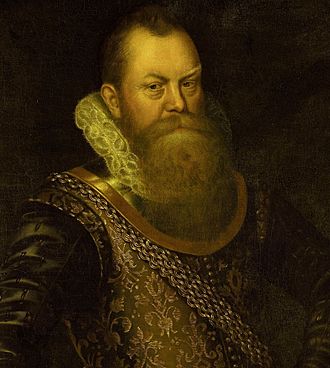Frederick de Houtman facts for kids
Quick facts for kids
Frederick de Houtman
|
|
|---|---|

De Houtman c. 1615
|
|
| Governor of the Moluccas | |
| In office 11 July 1621 – 25 February 1623 |
|
| Preceded by | Laurens Reael |
| Succeeded by | Jacques le Fèbre |
| Governor of Amboyna | |
| In office 1 March 1605 – 18 February 1611 |
|
| Preceded by | Office established |
| Succeeded by | Caspar Janszoon |
| Personal details | |
| Born |
Frederik de Houtman
Unknown date, c. 1571 Gouda, South Holland, Seventeen Provinces |
| Died | 21 October 1627 (aged 55–56) Alkmaar, North Holland, Dutch Republic |
| Spouse | Vrouwtje Cornelisdr Clock |
| Relatives | Cornelis de Houtman (brother) |
| Occupation |
|
| Employer | |
| Expeditions |
|
Frederick de Houtman (around 1571 – 21 October 1627) was a Dutch explorer, navigator, and colonial governor. He sailed on the first Dutch expedition to the East Indies from 1595 to 1597. During this time, he carefully watched the stars in the southern sky. His observations helped create 12 new constellations that we still know today.
Contents
Exploring the World
Adventures in the East Indies
Frederick de Houtman was born in Gouda, a city in the Netherlands. He was very interested in the stars. On his first trip to the East Indies (from 1595 to 1597), he helped another Dutch navigator, Pieter Dirkszoon Keyser. Together, they made important astronomical observations. They focused on the stars visible only from the southern part of the world.
In 1598, De Houtman went on a second expedition. This trip was led by his brother, Cornelis de Houtman. Sadly, his brother was killed during this journey. Frederick himself was captured by the Sultan of Aceh in northern Sumatra.
He was held captive for two years, from September 1599 to August 1601. But Frederick didn't waste this time! He used it to learn the local Malay language. He also continued to make more observations of the stars. These new observations added to what Keyser had seen on the first trip.
The new constellations they found were first shown on a globe in 1597 or 1598. This globe was made by Petrus Plancius. Later globes were updated using De Houtman's newer observations. Many people give credit for these constellations to Keyser, De Houtman, and Plancius. A famous mapmaker named Johann Bayer also included them in his star atlas, Uranometria, in 1603. After returning to Europe, De Houtman published his star observations. He put them in a special section of his dictionary and grammar for the Malayan and Malagasy languages.
Discovering Australia
In 1619, De Houtman sailed with the Dutch East India Company. He was on a ship called the Dordrecht. Another ship, the Amsterdam, sailed with him. They saw the coast of Australia near where the city of Perth is today. They named this area Dedelsland.
As they sailed north along the coast, De Houtman's ship almost hit a group of dangerous underwater rocks. These rocks are now known as the Houtman Abrolhos.
De Houtman then landed in a region called Eendrachtsland. Another explorer, Dirk Hartog, had already visited this area. In his travel journal, De Houtman wrote that these coasts were Locach. This was a place mentioned by Marco Polo as a country far south of China. Mapmakers like Plancius and Linschoten had also shown Locach on their maps.
See also
 In Spanish: Frederick de Houtman para niños
In Spanish: Frederick de Houtman para niños
- John Davis – An English explorer who was the pilot on the first East Indies' expedition with De Houtman.
Images for kids


